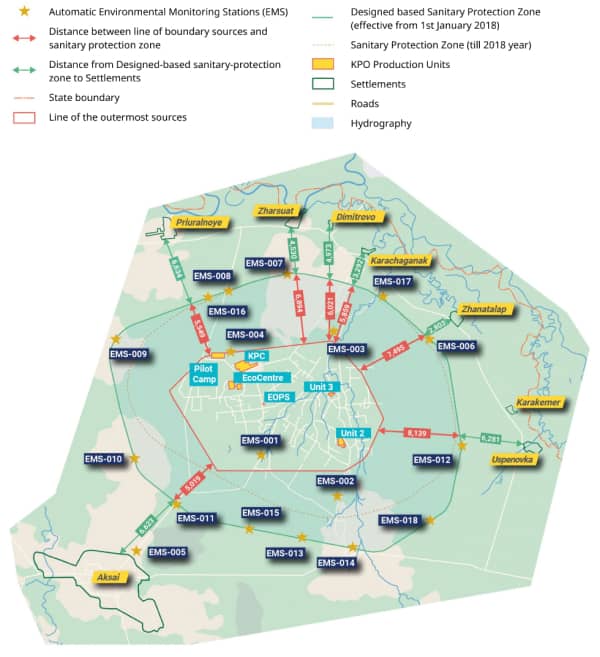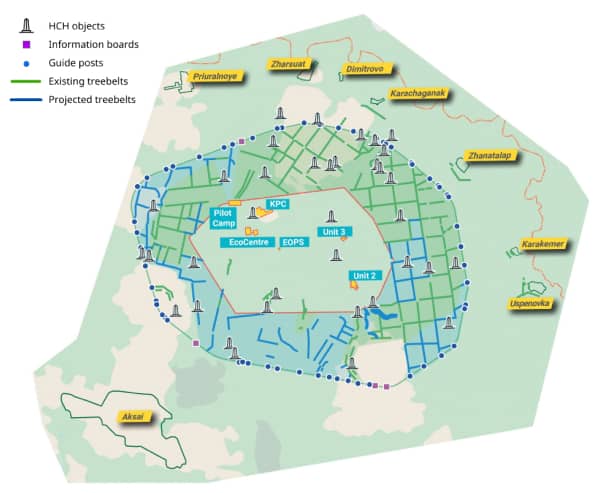Sustainability
- Home
- /
- Sustainability
- /
- Environmental monitoring
- /
- Sanitary protection zone
Sanitary protection zone
The current estimated Sanitary Protection Zone (SPZ) at the Karachaganak Oil Gas Condensate Field is valid from January 1, 2018.
During 2018-2021, KPO successfully completed the relocation of eleven of the existing eighteen air environmental monitoring stations. The relocation of these stations was scheduled due to the change of SPZ to ensure the correct performance of the continuous air monitoring and comply with the RK legal requirements.
Map of the Karachaganak Field with SPZ marked as of end 2023
(click on image to enlarge)
Development and upgrading of the ESPZ in the KGDBN
As part of the project «Development and upgrading of the Estimated Sanitary Protection Zone in the Karachaganak Field», KPO contemplates activities for planting new and caring for existing tree-planting. In addition, KPO provides for the installation of information signs at the SPZ boundary to inform the local communities and personnel.
In order to protect the historical and cultural heritage sites from potential negative impact, the project also provides for the installation of appropriate signs at the boundaries of the protected zones of the heritage sites. Earlier, in 2019, KPO organized the large-scale archeological research on this topic (see the details here)
In 2021, as part of this project, the Company performed preparatory works, including a full-scale inventory of all KPO tree-plantings, design of new tree-plantings and information signs, determination of the key technical and economic project performance.
In 2022, KPO continued the implementation of the project «Organization and improvement of the estimated KOGCF sanitary protection zone» — stage 3 — «The first stage of planting the KOGCF SPZ and for extending of SPZ boundaries». So, in 2022, surveys, field work, monitoring of existing forest plantations and project documentation were completed. Based on the results of the work performed, decisions were made on the reconstruction of previously planted plantations around the settlements of Uspenovka, Karakemer, Zhanatalap, Karashyganak, forest belts within the SPZ, the creation of new forest belts within the SPZ boundaries, the staking out of the SPZ boundaries, the installation of information signs and the boundaries of protected zones of historical and cultural heritage objects, the technology of their creation is determined, the costs for the implementation of the planned activities are calculated.
In 2023, KPO continued the implementation of the project «Organization and improvement of the estimated KOGCF sanitary protection zone », completing stage 3 ″ The first stage of planting the KOGCF SPZ and for extending of SPZ boundaries ".
In 2023, the boundaries of the SPZ were removed in kind, including the installation of information signs and boundaries of protected areas of historical and cultural heritage sites.
Total area of plots planned for green construction for the entire project period will be 249.1 hectares including 151.9 hectares area to create new forest belts, 97.2 hectares is the area of reconstruction work on existing plantations.
Total implementation period for the entire project includes the period from spring 2023 until 2028:
- 2022 — surveys, field work, development of project documentation,
- 2023 — drawing SPZ boundaries,
- 2024 — installation of information signs on SPZ boundaries and protected historical sites,
- 2023 −2026 — renovation of forest belts,
- 2025 — 2028 — planting of new forest belts.
The project will be coordinated with all stakeholders: state authorities, economic organizations and agricultural producers.
Key design solutions of the development and upgrading of KOGCF ESPZ for the period of 2023 — 2028
(click on image to enlarge)






